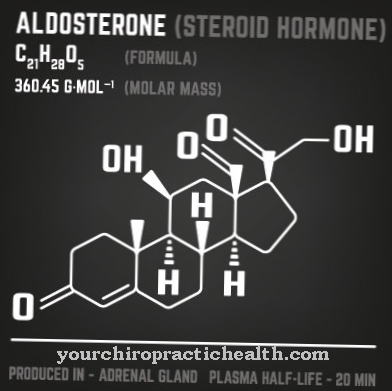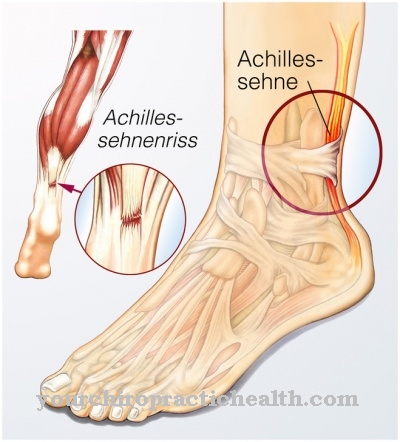That expresses seldom occurring Gorham-Stout Syndrome is a disease of the skeletal system. The bone dissolves and is replaced by blood and lymph tissue in the affected area.
What is Gorham Stout Syndrome?

© stockshoppe - stock.adobe.com
Gorham-Stout Syndrome is also called Vanishing Bone Disease designated. This is a very rare disease that affects the human bone system. The bone begins to dissolve locally.
In its place, blood and lymph vessels grow and multiply very quickly. In principle, this can happen anywhere in the entire skeletal system. The dissolution of the bone can be classified as a massive appearance. The condition is primarily diagnosed in children and young adults.
It is not yet known to be found in old people. There is no gender-specific probability of the occurrence of Gorham-Stout syndrome. Both sexes are equally affected. The sporadic occurrence of bone loss in those affected can be regarded as a peculiarity of Gorham-Stout syndrome.
In addition, bone loss can end spontaneously. The Gorham-Stout Syndrome was first documented by medical professionals in the middle of the last century. The Gorham-Stout syndrome was named after Whittington Gorham and Arthur Stout.
The American pathologist and his colleague discovered the rare disease in 1955. So far, fewer than 200 cases of affected patients have been known and documented worldwide.
causes
The rare occurrence and the so far low number of sick people mean that the exact causes are still largely unclear among researchers and scientists. It has been shown that the messenger substance interleukin-6 plays a central role in the course of the disease. Interleukin-6 is responsible for regulating the complex inflammatory reaction in the organism.
The effectiveness and functionality of interleukin-6 is particularly important in acute inflammatory episodes in the body. In patients with Gorham-Stout syndrome, it was found that interleukin-6 does not perform the regulatory function adequately. The reasons for this are not yet known. As a result, the scientists assume that there is increased osteoclast activity or angiomatosis.
Osteoclasts are cells that arise from the bone marrow and whose tasks in the organism are the resorption of bone tissue. Angiomatosis refers to tumors in the area of the blood and lymph vessels. These arise when the immune system is weakened.
You can find your medication here
➔ Medicines for painSymptoms, ailments & signs
People with Gorham-Stout syndrome have an accumulation of lymph fluid, also called chylothorax. This happens in the area of the chest cavity or so-called pleural cavity. As soon as a thoracic manifestation occurs at the level of the rib cage, pulmonary complications can occur.
These include respiratory infections, bronchospasm, respiratory failure, pneumothorax, atelectasis, pneumonitis, or a pleural effusion. The first signs are symptoms such as a general feeling of pain, swelling, and fractures. Gorham-Stout syndrome causes discomfort to one or more bones.
Usually these are adjacent and increase the local pain. The complaints tend to occur in the area of the pelvis, shoulder girdle, spine and skull. There are very few documented cases where extremities are affected.
Usually the patient's bone tissue disappears completely in the affected areas and is replaced by blood and lymph vessels. The region in which there was once a solid bone in the body becomes a soft, so-called fibrous ligament consisting of connective tissue.
diagnosis
The diagnosis of Gorham-Stout syndrome is clinical. A number of other conditions must be ruled out before it can be diagnosed. These include above all infectious diseases, inflammations, tumors and endocrine diseases.
Radiological examinations take place and tissue samples are taken from the affected areas. Histopathological examinations mean that microscopically the tissue can be clearly defined as blood and lymph vessels.
Since a large number of different examinations are necessary, the Gorham-Stout syndrome is a follow-up diagnosis and not so much an initial diagnosis. A special feature of the disease is that the progression and thus the progression of the disease can come to an end spontaneously at any time without further signs.
Complications
The Gorham-Stout syndrome mainly causes discomfort in the chest and respiratory tract. The respiratory tract can be infected relatively easily, leading to severe inflammation and discomfort. In the worst case, the patient dies from such an infection. Pain also increases in these regions, which significantly reduces the patient's quality of life.
Certain regions in the body can swell and pain, whereby the pain also occurs in the form of pain at rest. Often times, pain at rest leads to sleep disorders and irritability in the patient. Furthermore, the Gorham-Stout Syndrome causes damage to the skull and also to the spine.
The patient is generally susceptible to various diseases and infections. Gorham-Stout syndrome also greatly increases the risk of developing tumors. The treatment cannot be causal and therefore always depends on the underlying disease.
The patient must undergo radiation and, if necessary, take medication. Whether the disease can be limited by treatment cannot be universally predicted. In most cases, however, life expectancy is reduced.
When should you go to the doctor?
Treatment of Gorham-Stout Syndrome is always necessary. If treatment is not available, in the worst case scenario the person affected can die of the disease. The person affected should then consult a doctor if there are infections of the respiratory tract and thus various breathing difficulties.
A blue discoloration of the skin can also indicate the syndrome and should be examined by a doctor. Many patients experience severe pain or swelling. Fractures can also occur. In general, fractures must always be treated by a doctor to prevent the bones from growing together improperly. This will prevent further complications and complaints.
As a rule, those affected with Gorham stout syndrome should see a general practitioner. He can then refer the patient to a specialist who will carry out the treatment. However, in serious cases or after an accident, treatment in a hospital is necessary. An emergency doctor can also be called.
Doctors & therapists in your area
Treatment & Therapy
Due to the rarity of the disease and the very manageable number of documented cases, a completely adequate and recognized treatment has not yet been found. Researchers and scientists therefore work individually and use different approaches. Well-known interventions are, for example, radiation therapy and chemotherapy as well as the administration of various drugs.
These are administered alone or in combination. Mostly, preparations such as vitamin D, calcium glycerophosphate or sodium fluoride are used. Bisphosphonates are also used. These are chemical substances that have been specially developed for bone diseases and are designed to stop the bone from breaking down.
Interferon-α2b is often administered to the patient as a support. These are cellular antibodies that the body produces itself against the spread of viral infections in the tissues. Several operational interventions have already been successfully implemented. If possible, the lymph fluid is removed and the pleura is connected to the pleura.
In one documented case, a patient whose spine was affected was surgically stabilized and a vertebral body fusion was performed. A combined posterior and anterior stabilization was performed, extending along the entire spine from the back of the head to the thoracic spine.
There was no further spread of the disease in the later course. Since the disease spontaneously came to a standstill several times in affected patients, it is difficult to establish a sufficient treatment regimen.
Outlook & forecast
The position of a uniform or manageable prognosis cannot be given solidly for the syndrome. Basically, with Gorham-Stout Syndrome there can be a spontaneous interruption in the progression of the disease at any time. It has been reported several times that the disease has come to a sudden and unexpected standstill in the patient for no sufficiently comprehensible reason. Regardless of the stage of the disease, there is therefore the possibility that the symptoms will not increase and that the gradual bone loss will stop automatically.
In a large number of cases, however, an unfavorable course is documented. Although there are so far not many patients with this disease worldwide, most of those affected experience a significant reduction in average life expectancy. Since the respiratory tract is affected in Gorham-Stout Syndrome, severe complaints and complications occur in this area in particular. These lead to a reduced life expectancy and thus to an unfavorable prognosis.
Due to the small number of sufferers, it has not yet been possible to determine the exact causes of the disease, nor is there a uniform treatment plan for all patients. This makes it difficult to deal with the disease and creates difficulties in obtaining optimal medical care. In addition, the reasons for the repeated stoppage in the progression of the disease have not yet been sufficiently clarified.
You can find your medication here
➔ Medicines for painprevention
The possibility of taking preventive measures are not known.
Aftercare
With Gorham-Stout syndrome, follow-up care options are very limited in most cases. Those affected are primarily dependent on the direct treatment of the symptoms by a doctor, although a complete cure cannot always be guaranteed. The life expectancy of the person affected by Gorham-Stout syndrome may also be limited or reduced.
In most cases, treatment is through chemotherapy or radiation therapy. Those affected are often dependent on the support of friends and family. Psychological support is also very important in order to alleviate the symptoms. The intake of vitamin D can also be helpful and support the treatment.
The patient should ensure that it is taken regularly to alleviate the symptoms. Surgical interventions are not uncommon for Gorham-Stout syndrome. Those affected should always rest after such an operation and take care of their body.
Exertion or other stressful activities should therefore be avoided. Since the treatment of Gorham-Stout syndrome is relatively lengthy, psychological treatment is often necessary, in which relatives and friends can also take part.
You can do that yourself
It is not possible to treat Gorham-Stout Syndrome by means of self-help or to support the treatment by doing so. Patients with this disease are in any case dependent on medical treatment in order to avoid a reduced life expectancy.
Since the disease is often treated with chemotherapy, patients are often dependent on outside help in their everyday lives. This help should primarily come from friends or from one's own family and relieve the person concerned in everyday life.
Exhausting activities and unnecessary stress must be avoided at all costs. The intake of vitamin D, sodium and calcium can also have a positive effect on the course of the disease. However, you should always consult a doctor, as he should determine the amount of these supplements.
Since the Gorham-Stout syndrome often leads to psychological complaints, these can be alleviated by sensitive discussions with your own family or with other people you trust.
Children should be fully informed about the disease so that no further questions remain unanswered. Furthermore, the contact with other affected persons can have a positive effect on the course of the disease and possibly contribute to an exchange of information, which can ultimately improve the quality of life of the person concerned.




.jpg)






















